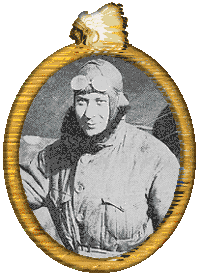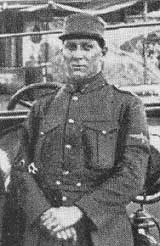 |
|||||||||
|
JAMES McCONNELL
|
|||||||||
James Rogers McConnell, a founding member of the Escadrille Americaine, was born in Chicago, Illinois, on 14 March, 1887, the son of Judge Samuel Parsons McConnell and Sarah (Rogers) McConnell. McConnell's paternal grandfather was Union General John McConnell. His maternal grand-father was Judge John G. Rogers of Chicago. |
|||||||||
Judge Samuel P. McConnell served on the Circuit Court of Cook County, Illinois from 1889 to 1894 when he left the bench for private practice. In 1899 he moved his family, then to include two sons and two daughters, to New York City to become President of the George A. Fuller Company, a large building contracting corporation. He also served as legal representative for the Vanderbilt interests.
While the McConnells were in New York their son, Rogers, died of a fever. Following his untimely death Sarah McConnell became a "nervous invalid," who relegated the responsibilities of her youngest children to her daughter, Julia. Eventually the McConnell's were divorced, and in 1902 Judge McConnell married Mayo Methot, a domestic servant. From that union another son and two daughters were born. While still in his pre-teens, young James McConnell spent a portion of his childhood in France with his mother and two small sisters. And it was there that he had learned to speak French fluently. In his youth he had suffered from muscular rheumatism which again surfaced with savage intensity in his adult life. |
|||||||||
 |
|||||||||
In 1905, Judge McConnell left New York City for Carthage, North Carolina to become president of the Randolph & Cumberland Railway Company. He also acted as general manager of the Deep River Development Company. When his family had been living in New York, James attended the Morristown School, New Jersey, and the Haverford School, Pennsylvania. Following a summer vacation in Chicago, he and a friend had driven the first automobile from Chicago to New York City. |
|||||||||
This feat had attracted much attention in the towns and cities along his route as McConnell was often greeted by large crowds whose interest had been stirred by the local press. James had chosen to enroll in the University of Virginia upon Judge McConnell's relocation to the South. While pursuing a law degree as a member of the class of 1910, he soon became one of the best-known students in Charlottesville by outfitting himself in a Scottish kilt and full regalia in the tartan of his clan. Having taught himself to play the bagpipes, McConnell then paraded about the campus and the streets of Charlottesville piping music which few appreciated and was an irritation to many. Considered a brilliant student, McConnell easily mastered his studies. However, he developed a prankster's reputation and was nearly expelled from the University when he placed a chamber pot on the head of a statue of Thomas Jefferson prior to its unveiling on the University campus before President Taft and other assembled dignitaries. While he was at the University of Virginia, McConnell was made "King of the Hot Foot Society" and President of the Aero Club. But he abruptly left that institution in 1910 without his law degree.
There are rumors he was expelled. McConnell returned to New York City and involved himself briefly in business with future Lafayette Escadrille pilot, Charles Chouteau Johnson. Eventually he returned to Carthage to work as land and industrial agent for the Randolph & Cumberland Railway Company. James also served as a Second Lieutenant in the State Militia. But in January 1915 the twenty-seven year old McConnell left his position with the railroad in Carthage, and in a spirit of adventure sailed for France to observe the war. Not wanting to be a mere "sightseer looking on" McConnell joined the American Ambulance Field Service as a driver and served with Section No. 2 from February to December of 1915 through the heavy fighting near Pont-a-Mousson and the Bois-le-Pretre. On 5 October 1915, he was awarded France's Croix de Guerre, with Star for "courage and fearlessness worthy of the highest praise." But while McConnell was serving in the Ambulance Corps with future Lafayette Escadrille pilots Harold Willis and Walter Lovell, he felt the need to participate more actively in the war. "The more I saw the splendor of the fight the French were fighting the more I began to feel like an embusque (shirker)" he wrote. "So I made up my mind to go into aviation." McConnell joined the Service Aeronautique on 1 October 1915. Upon receiving a new uniform and equipment at Dijon, he immediately began his aviation schooling at Pau. On 6 February 1916, he received his brevet militaire on the Bleriot. Following Nieuport instruction, on 16 April he joined Victor Chapman and Kiffin Rockwell at the R.G.A.(Reserve General Aeronautique) near Paris and was immediately assigned to the Escadrille Americaine. McConnell reached the Front on 20 April 1916 at Luxeuil, in the Vosges, one of the first seven American pilots to be assigned to the newly-formed N.I 24. Soon after he was given his Nieuport fighter, he had his personal insignia painted on its sides: his nickname, "MAC", and a large white footprint to represent the "Hot Foot Society" of his alma mater. On the morning of 13 May he flew with Capitaine Thenault, Victor Chapman, Kiffin Rockwell, and William Thaw southwest of Mulhouse as part of the Squadron's maiden flight over the lines. The only resistance the patrol met came from antiaircraft fire. On 20 May, the Squadron completed its relocation to Behonne in the Verdun sector where the American pilots were ordered to protect allied observation and artillery reglage machines from enemy fighters. Air activity greatly intensified, and on 23 June McConnell's close friend, Victor Chapman was killed in combat in the air northeast of Douaumont in a battle with five enemy fighters. McConnell chafed to avenge Chapman's death. On 30 June, while on a morning patrol over Verdun, he and Raoul Lufbery attacked a German machine and sent it groundward out of control. However, it was not officially confirmed by balloon observers or by ground troops. In August, in addition to his regular patrol duty, McConnell often hunted German drachen with Norman Prince. He hovered above Prince, flying cover, while his comrade attacked the balloons with Le Prieur rockets rigged to the V struts of his fighter. After several unsuccessful attempts, their teamwork met with success. As McConnell flew cover overhead. Prince dove on a black observation balloon and fired a salvo into it, successfully incinerating it. In the third week of August with the Squadron still at Bar-le-Duc, McConnell left on a late afternoon patrol with Kiffin Rockwell and Norman Prince. In conjunction with an allied attack near Fleury and Thiaumont, their objective was to drive off enemy observation machines. McConnell and Prince had remained in the air past dusk to be sure of no further German activity before heading back to their aerodrome. The stars shown brightly above them as they nosed their ships about. Below they watched the spurt of infantry signal flares. While still some distance from his aerodrome, McConnell's engine sputtered and he immediately suffered a panne de moteur. He spotted the flares of another aerodrome below and nosed his Nieuport downward. He approached the airfield at a terrific speed, nearly one hundred miles an hour, misjudged his distance in the darkness, and overshot the landing strip. As his plane sped toward a stand of trees, he glimpsed soldiers running across the field toward his inevitable crash site. McConnell's luck held. Instead of hitting the trees, he plowed between them and tore off both wings before jumping a road and splintering his propeller against a steep bank. His motor absorbed most of the shock, and his safety belt held as the tail of his Nieuport catapulted skyward and was sliced in two by low-strung phone wires. McConnell had a first thought himself uninjured and had dined as a guest at the Squadron's mess. But on his return by car to Behonne he found himself in a state of ever-increasing pain and realized he had severely wrenched his back. Although he continued to fly for several days after his accident, soon he could not dress himself and could only walk with a cane. He took a brief Paris leave, hoping the condition would abate. But by the time he returned to Bar-le-Duc he could not walk. On 26 August Capitaine Thenault ordered him to hospital. McConnell vigorously protested, saying: "Not being able to walk does not prevent my flying." Thenault merely replied, "Jimmy, go to bed." and ordered McConnell to the auxiliary hospital at Vitry-le-Francois. While in hospital McConnell wrote a 19 September 1916 letter to a friend in Paris. "I am getting discouraged about my back," he had said. "It seems to be getting well and then flop, she drops back to first condition. If it doesn't build up soon, I am going to tell them I am well." McConnell became ever more anxious to rejoin the Squadron upon hearing of the death on 23 September of Kiffin Rockwell, his closest friend. But he knew that physically he could not. He requested his doctor's permission to journey to Paris to continue his recuperation at the residence of Mrs. Alice Weeks. McConnell arrived in Paris on the 27th and recuperated for 45 days at Mrs. Weeks's apartment at 80 Rue Boissiere. He used the time to work on the book he had begun in the hospital concerning his experiences with the Escadrille Americaine. |
|||||||||
|
All rights reserved « The Lafayette Flying Corps »:
The American Volunteers in the French Air Service in World War One Written by Dennis GORDON A SCHIFFER MILITARY HISTORY BOOK - (Schifferbk@aol.com) |
|||||||||